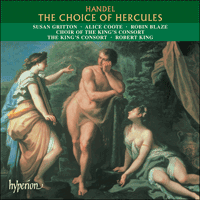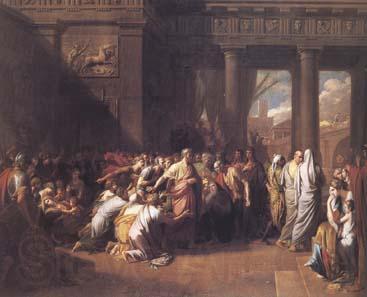Make of that what you will --obviously, in the fashion of a Nineteenth Century novelist writing for a pastor who wants something to read to the congregation after service, I'm trying to imply something that I can't just straight out say-- , let's move on to just what, exactly, he was exhibiting in 1772: not a royal commission, but rather one from Thomas Penn, Proprietor of Pennsylvania: Penn's Treaty With the Indians
 |
| Courtesy of the Pennsylvania Academy of Fine Arts. Via |
 |
| Via Moby's Newt, Ltd. |
So, let's look at this image. Ostensibly, this is Pennsylvania's founding proprietor, William Penn (1638--1717) making a treaty under the Shackamaxon Elm with Tamanend, or Tammany, Turtle Clan Chief Sachem of the Leni Lenape, or Delawares. No copy of this treaty survives in the Penn's archives, and we can even doubt that it happened as a historical event. That doesn't make the painting go away, though, and the first point of interest here is that Penn was only in America in 1680--4 and 1700--02. The fact that West chooses to represent Penn as a man closer to 60 than to 45 is, thus, either a pretty obvious mistake by a painter who was well known for his research, or a deliberate choice of a man who often sacrificed strict historical accuracy for deeper truths. Ordinarily, West preferred to make his allegorical statements as clearly as possible, but this painting is a commission, and it is Thomas Penn talking to us more than West.
So what do we make of the "mistake" over Penn's age? The fact that Philadelphia is shown as a going concern in the background suggests rather strongly that this painting is actually set during his second visit. Tamanend has been said to have died as late as the 1750s (he shows up, for example, at the climax of Last of the Mohicans, set in 1758), but the traditional story has him immolating himself on his own funeral pyre. That's a bit of mythologising, and what documents we have suggest a death in 1698. So Tamanend isn't in the painting. But then, he's not in the painting's title, either.
Now: about that reversal. Socrates tells a story about Hercules: once, when he was young, the great hero ran into two chicks on the road who totally wanted to do him: one was Vice, the other Virtue. Well, I guess he'd have to marry Virtue before he saw some action, because that's her thing, but Vice, I hear, is easy. Anyway, Socrates ends his story by saying that you can tell from what you've heard of the rest of Hercules' career which choice he made. Now, Socrates could be an earthy guy, and he was telling this story to his pupil, Plato, who was a bit of prig, and also not into girls. So even though we have this story from Plato, this might be one of these cases where his old teacher stops being a sockpuppet and says something that Plato doesn't really intend to say. Or maybe not. Times change, and so do perceptions of old Hercules.
 |
| Antonio Caracci, The Choice of Hercules, via The Epicurean Dealmaker |
 |
| Not one of West's more Internet-famous paintings. Thank Heavens for album covers, and Hyperion's online catalogue! |
Of course, this might be a crazy coincidence. Who am I to make a bold claim that this well-known painting is deliberately reversed? Well, let's look at West's big painting, his claim to fame: The Death of Wolfe.
 |
| Driving a little traffic towards one Professor Fedoruk at my alma mater |
Now that I've looked at the overall painting, details, clockwise from the middle. In the foreground, bow and arrows. The common interpretation is that these signify the savage Indian. I'd call that a little forced even if we couldn't look to West for a refutation in the form of The Savage Chief, sometimes also called the Mohawk Apollo:
 |
| Via another fascinating blog |
Moving around the painting, you can see two young Englishmen to foreground left. Notice the absence of any foregrounded people taking attention away from the central group in Death.
 |
| I hope this link sells some art for Steve Art Gallery, notwithstanding the website! |
So Treaty, I'm saying, might not be "about" the central group. Well, let's look at these guys. This is the central, lighted image of the painting. Of course it is. Everyone knows that Indian treaties are done at a council fire. Except that the central image of the painting is no fire, but rather a brilliant piece of white cloth. That's odd. Maybe West didn't understand that while Indians make treaties around fires, they give clothing to the bride's family as a wedding gift. (I tried to find the classic woodprint of a Mohawk wedding to link to here, and instead found that a surprising number of people wear Mohawks at their weddings.) And that brings us around to our righthand side (but left-hand side when you reverse the painting into a woodprint) group: an Indian mother with her baby, and a bare-chested maiden, just come into marriageable age, I'd say, given that she's wearing pendant earrings. (At least, marriageable by the pedophiliac standards of old-timey aristocratic marriages.)
William Penn returned to America in the company of his second wife, Hannah Margaret Callowhill (1671--1726). His first wife, Gulielma Maria Springett, had died in 1694, and he left his sons by that marriage at home. John Penn, "the American" was born there to Hannah. William, Junior, William Penn's eldest son by Gulielma, followed his father to America and was governor there for two years before departing in disgrace for unknown reasons. This began the breach between the two branches of the Penn family that continued through court cases over ownership of estates in Ireland as well as Pennsylvania itself. Ultimately, Hannah's surviving sons, John, Thomas, and Richard, ended up with Pennsylvania, while William, Junior's son, Springett, received "only" 56,000 acres in the vicinity of York, Pennsylvania, as well as a modicum in Ireland.
What has this to do with the painting? Well, the commission of 1772 celebrates the secure and solid Penn control of Pennsylvania. It's not solid and secure if there are aggrieved family members still at large. So I'm going to go out on a limb and say that by 1772, everyone in that painting, both the sons of the two wives of William Penn, and the semi-anonymous Indians on the other side are satisfied that the terms of the Treaty have been satisfied. How did that come to happen? Well, how is it that Benjamin Franklin's painting appears on the wall at Temple Hall, where we would expect Judge Marmaduke Temple to celebrate his ancestors. Judge Temple, of course, "comes from nothing." That's how we see him, and even Lauren Groff, so eager in other cases to ferret out matrimonial irregularities, seems to accept it.
I don't. And, I think, for good reason. But for now, let's leave it with this. The Penn's Indian treaty for Pennsylvania was a marriage treaty with Turtle Clan. That, I think, is what this painting is saying, and very clearly. I'm certainly not the first to allege that there are "Indian princesses" involved in the story of a family that couldn't always keep it in their pants. Where I'm going to take this will be a bit more adventurous than unsourced allegations, however.
For now, the painting stands by itself, not as a statement of some encoded, lost historical fact. (Me and Dan Brown --like brothers from another mother!) It stands as a statement, read, embraced, understood, and celebrated in America as the country moved towards Revolution; a statement about how differences of family, race, and even culture are bridged at the marriage altar. (This comes later.)
No comments:
Post a Comment